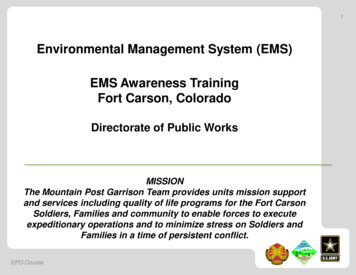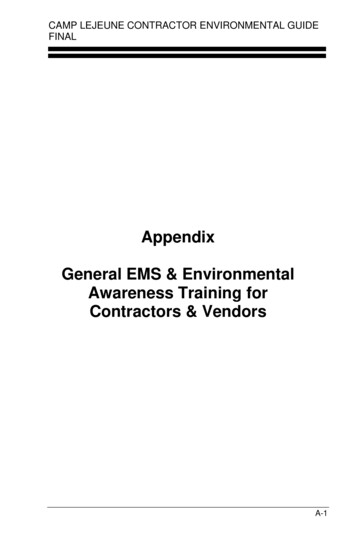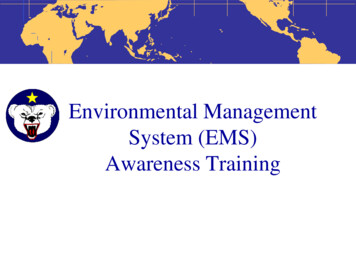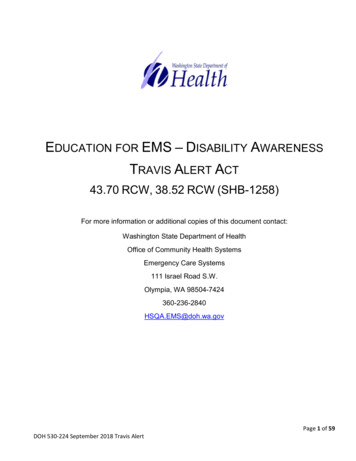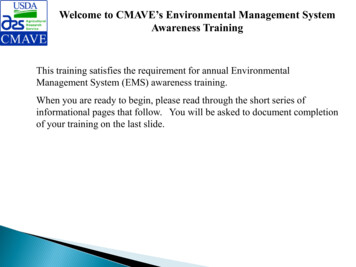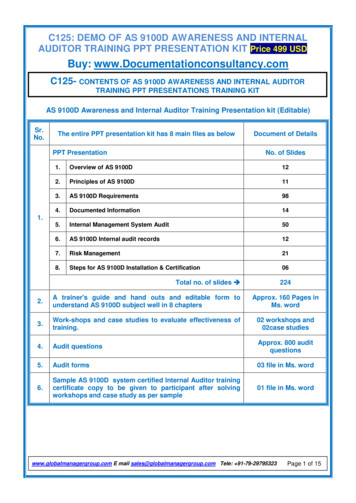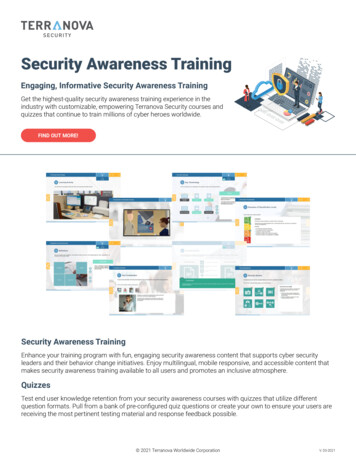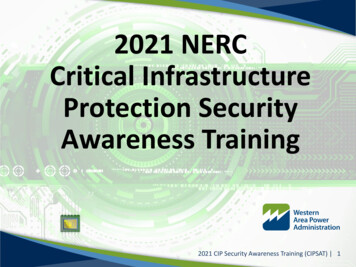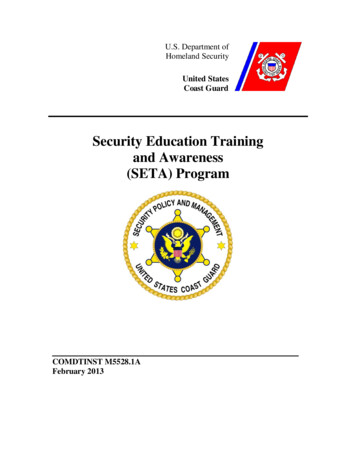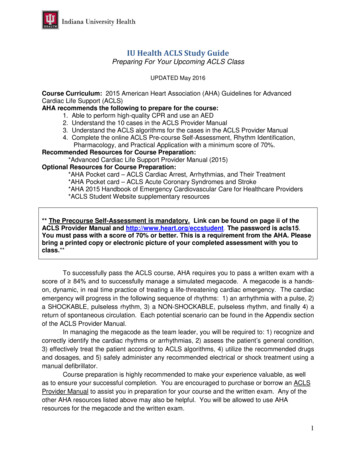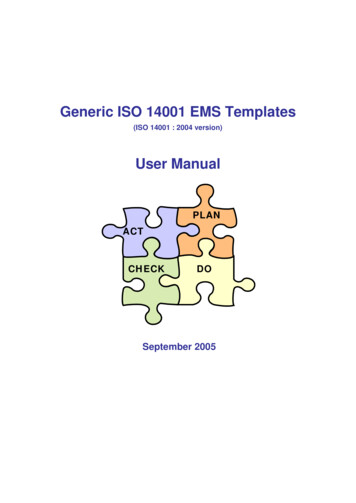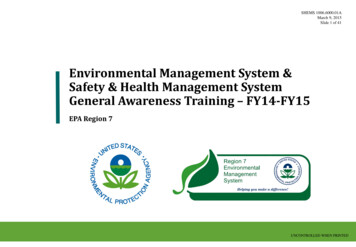
Transcription
SHEMS 1006.6000.01AMarch 9, 2015Slide 1 of 41Environmental Management System &Safety & Health Management SystemGeneral Awareness Training – FY14-FY15EPA Region 7Client LogoUNCONTROLLED WHEN PRINTED
Management System OverviewPolicy, Scope, Significant Aspects,Hazards/Risks, Objectives & Targets, MPsSHEMS 1006.6000.01AMarch 9, 2015Slide 2 of 41Region 7 uses the robust Plan-Do-Check-Actcontinual improvement management systemprocess for both the EMS and SHMSImplement EMPs & SMPs, Training,Monitor, and Operational ControlsCorrective Actions andManagement ReviewAssess Compliance and EMSAuditThe Region’s EMS operates on a fiscalyear (FY) cycle, while the SHMS is ona calendar year (CY) cycleUNCONTROLLED WHEN PRINTED
Management System OverviewSHEMS 1006.6000.01AMarch 9, 2015Slide 3 of 41DefinitionThat part of an overall management system the includes organizationalstructure, planning activities, responsibilities, practices, procedures, processes,and resources for developing, implementing, archiving, reviewing, andmaintaining individual programs and achieving performance goals. Provides astructured framework for: Organizing and managing environmental responsibilities;Evaluating the quality of the environment and determininghow it is affected by the organizational mission; andConducting a self-evaluation of the effectiveness of the MSin achieving desired levels of performanceUNCONTROLLED WHEN PRINTED
Management System OverviewSHEMS 1006.6000.01AMarch 9, 2015Slide 4 of 41Region 7 EMS History The Science & Technology Center completed allimplementation actions March 2005, the externalverification audit in April 2005, and self-declared itsEMS to be “in-place” in October 2005The Regional Office completed all implementationactions in September 2005, the external verificationaudit in October 2005, and self-declared its EMS to be“in-place” in October 2005The Regional Office and STC EMSs were mergedtogether in November 2007; TLC addedThe Regional EMS was initially certified to the ISO14001 Standard in February 2009; it was recertified inJanuary 2012 and again in January 2015The current cycle started in October 2013Certified to ISO 14001:2004Certificate Number 42708UNCONTROLLED WHEN PRINTED
Management System OverviewSHEMS 1006.6000.01AMarch 9, 2015Slide 5 of 41Region 7 SHMS History The Region initiated actions to develop the SHMS as asingle system in 2009Actions were halted in late 2011 to allow for the RO moveto take place (changes the dynamic of the system)Implementation of the SHMS resumed in April 2013 andwas completed in March 2014SHEMD conducted a conformance audit in April 2014; nonon conformances were noted and the system wasdeclared “officially complete” at that time.The current cycle started in January 2015UNCONTROLLED WHEN PRINTED
MS Planning PhaseSHEMS 1006.6000.01AMarch 9, 2015Slide 6 of 41ScopeThe MS Planning Phase (PLAN) begins with defining the MS scopeand developing a policy statement. The Scope is a declarative statement of whatyou purposefully include, and in some casesexclude, from the management systemThe Scope typically encompasses activitieswithin facility’s “fenceline” for which theyhave regulatory authority and liability Can change with the addition or transfer ofproperty and/or the gain or loss of missionCan also include activities over which thefacility can exert a certain amount of influenceUNCONTROLLED WHEN PRINTED
MS Planning PhaseSHEMS 1006.6000.01AMarch 9, 2015Slide 7 of 41ScopeThe Region’s MS scope includes the following: Locations: The Regional Office (RO), Science& Technology Center (STC), Training &Logistics Center (TLC) Personnel: All EPA staff, grantees, andcontractors working in these locations EMS: Field Offices (GOV use only)SHMS: Field Offices (All Activities)SHMS: Includes visitorsActivities: Essentially all activities that takeplace in these locations; also includes EMS: Influencing employee commutingSHMS: Employee Wellness – commitment toencourage adoption of healthy lifestyle choicesUNCONTROLLED WHEN PRINTED
SHEMS 1006.6000.01AMarch 9, 2015Slide 8 of 41MS Planning PhasePolicy StatementThe Region’s MS policy statements are written to be specific to ourmission, work activities, and any regional concerns Per the ISO 14001 Standard, the EMS policy statement shall: Be signed by the Regional AdministratorCommit to continual improvement,prevention of pollution, and maintainingregulatory complianceBe reviewed at least once per EMS cycleRegion 7’s Sustainability Policy includesseveral unique commitments to advancethe understanding and implementation ofsustainability principles and practicesUNCONTROLLED WHEN PRINTED
MS Planning PhaseSHEMS 1006.6000.01AMarch 9, 2015Slide 9 of 41Policy StatementIn accordance with OHSAS 18001, the SHMS policy statementdefines Senior Staff’s desire to “provide and maintain a safeand healthy work environment and encourage all parties toregard injury and ill health prevention as both a collective andan individual responsibility.” It includes commitments to: Lead by example in complying with legal &other requirementsContinual improvement in our safety and healthperformance by proactively identifying and, tothe greatest extent practical, mitigating safetyand health risks to prevent injury and ill health.Communicate the SHMS policy to all levels ofthe organization, to visitors, and to the public atlarge.Don’t get sick; don’t get hurt!UNCONTROLLED WHEN PRINTED
MS Planning PhaseSHEMS 1006.6000.01AMarch 9, 2015Slide 10 of 41Aspects & ImpactsWith the MS scope and policy statement completed, the Planning Phaseshifts to identifying appropriate legal and other requirements and, forthe EMS, environmental aspects and impacts; setting objectives andtargets; and developing management programs. Environmental Aspects: The interaction, or potential interaction of a facility’s activities,products, and services (i.e., processes) with the environment. Aspects can be positive(generate recyclable material) or negative (consumption of energy).Environmental Impacts: Any change, or potential change, to the environment resultingfrom the facility’s aspects. Impacts can be positive (improve natural resources) ornegative (degrade air quality).UNCONTROLLED WHEN PRINTED
MS Planning PhaseSHEMS 1006.6000.01AMarch 9, 2015Slide 11 of 41Aspects & ImpactsEXAMPLE – Vehicle Maintenance FacilityActivity:Vehicle maintenanceImpacts:Reduction in landfill spaceDegradation of air qualityProcess:Aspects:Degrease metal parts, solvent wipeGenerate hazardous waste (rags)Generation non-hazardous waste/recyclablematerialsEmit VOCs to the airUNCONTROLLED WHEN PRINTED
MS Planning PhaseSHEMS 1006.6000.01AMarch 9, 2015Slide 12 of 41Aspects & Impacts Aspects that represent the greatest harm (or benefit) are designatedas significant aspectsRegion 7 declares that all aspects governed by legal or otherrequirements will be designated as significant aspects; other aspectswhose impacts are considered to be substantial may also be declaredto be significantEMS Coordinator will also determine if the “breadth and scope” ofsignificance of a generic aspect is such that its application as asignificant aspect should be limited Limited to specific locations and/or conditionsUNCONTROLLED WHEN PRINTED
SHEMS 1006.6000.01AMarch 9, 2015Slide 13 of 41MS Planning PhaseAspects & ImpactsApplicable to all Facilities Consumption of Energy to Support Facility OperationsConsumption of Energy to Support Administrative FunctionsConsumption of Land/PropertyConsumption of Materials to Support Office AdministrativeFunctionsConsumption of Water to Support Facility OperationsEmissions to the Air from Employee Travel*Emissions to the Air from Employee CommutingGeneration of Recyclable MaterialsApplicable to Select Facilities Consumption of Materials to Support Food Servicesat the ROApplications to the Land from Facility Operations atthe RO and STCConsumption of Fuel for Fleet Vehicles at the STCGeneration of Hazardous Waste at the STCEmissions to the Air from Facility Operations at theTLCDeleted Discharges to the Sanitary Sewer at the STCConsumption of Materials to Support FacilityOperationsConsumption of Materials to Support LaboratoryOperationsUNCONTROLLED WHEN PRINTED
MS Planning PhaseSHEMS 1006.6000.01AMarch 9, 2015Slide 14 of 41Hazards & RisksWith the MS scope and policy statement completed, the Planning Phaseshifts to identifying appropriate legal and other requirements and, forthe SHMS, completing hazard identification and risk assessments;setting objectives and targets; and developing management programs. Hazard: A source, situation, or act with a potential for harm in terms of humaninjury or ill health, or a combination thereof.Risk: A combination of the likelihood of an occurrence of a hazardous event orexposure(s) and the severity of injury or ill health that can be caused by theevent or exposure(s).UNCONTROLLED WHEN PRINTED
MS Planning PhaseSHEMS 1006.6000.01AMarch 9, 2015Slide 15 of 41Hazards & RisksA risk assessment is process of evaluating the risk(s) arising froma hazard(s), taking into account the adequacy of any existingcontrols, and deciding whether or not the risk(s) is acceptable. Example: Stream Clean-upHazard: Drowning; physical injury fromfalling; illness from toxic substance on thewater.Risk: Likelihood of Occurrence – Low (people, lifevests)Severity of Injury or Ill Health – Catastrophic(death).There is no such thing as insignificant risk; all riskmust be mitigated to acceptable levels!UNCONTROLLED WHEN PRINTED
SHEMS 1006.6000.01AMarch 9, 2015Slide 16 of 41Job Hazard Analysis (JHAs) Purpose of the JHA process is to determine the jobs peopleperform, the hazard(s) associated with them, the inherent riskfrom those hazards (severity & probability), and the resultingresidual risk after all controls have been appliedMost of the Region is covered under three (3) “Generic” JHAs;each governed by one or more operational controls Office AdministrationGeneral Vehicle OperationsGeneral Field OperationsFound on the Health & Safety R7@Work Page; SHMS SectionUNCONTROLLED WHEN PRINTED
SHEMS 1006.6000.01AMarch 9, 2015Slide 17 of 41MS Planning PhaseManagement ProgramsUnder both the EMS and SHMS, we use management programs(MPs) to define the “who, what, where, when, and how” theobjectives and targets will be achieved. They typically do notchange from one cycle to the next and include the following: Designate responsibilities at each functional level including an overallprogram leadIdentify pertinent records, documents, and operational controlsInclude clear time lines for achieving milestones and performanceindicators for monitoring performanceUNCONTROLLED WHEN PRINTED
MS Planning PhaseSHEMS 1006.6000.01AMarch 9, 2015Slide 18 of 41Management ProgramsEMS Management Programs for FY14-15 Green Meeting Management Program – Diane HarrisHazardous Waste Management Program – Mike DavisReduce/Reuse/Recycle Management Program – Jennifer DawaniSustainability Opportunities & Applications Resource (SOAR) Program – Chris TaylorSustainable Facilities Management Program – Chris Taylor Emergency Generator Consultant – Joe RicardNational Environmental Policy Act (NEPA) Consultant – Larry ShepherdPesticides Management Consultant – Mark LesherTurf Management Consultant – Darrin BanksSustainable Purchasing Management Program – Janet ShearerSustainable Travel Management Program – Chris TaylorUNCONTROLLED WHEN PRINTED
SHEMS 1006.6000.01AMarch 9, 2015Slide 19 of 41MS Planning PhaseManagement ProgramsSHMS Management Programs for CY15Safety Programs Fire & Life Safety ManagementProgram (John Begley) General Safety ManagementProgram (Roy Krueger) Health ProgramsConfined space entryElectrical SafetyVehicle Safety ManagementProgram (Joe Ricard) Slips/trips/fallsMachine/hand tool useLand-based motor vehiclesTraileringWatercraftIndustrial Hygiene ManagementProgram (Roy Krueger) Hazard CommunicationHearing ConservationMedical SurveillancePPERespiratory ProtectionHazardous Material ManagementProgram (Mike Davis)Radiation Protection ManagementProgram (Chuck Hooper)UNCONTROLLED WHEN PRINTED
SHEMS 1006.6000.01AMarch 9, 2015Slide 20 of 41MS Planning PhaseObjectives & TargetsObjectives and targets are established forEMS significant aspects and SHMS hazards.They are what we choose to emphasize inthe management system and they must: Be consistent with the Region’spolicyEnsure compliance with all legal &other requirementsConsider available technology,resources, and missionrequirementsObjectives and targets often changefrom cycle-to-cycle as performanceimproves and emphases shiftPolicySignificantAspects orHazardsLegal / OtherRequirementsObjectivesand nRequirementsUNCONTROLLED WHEN PRINTED
SHEMS 1006.6000.01AMarch 9, 2015Slide 21 of 41MS Planning PhaseObjectives & Targets Objective General statement (e.g., reduce storm water burden)Maintain existing program (e.g., maintain compliance)Support continual improvement (simplify work process) Iterative improvements and/or stretch goalsGather more information (study or design)Target Support the achievement of the relevant objectiveS.M.A.R.T. (specific, measurable, achievable, realistic, time)Supportable with Performance IndicatorsAt least one target per objectiveUNCONTROLLED WHEN PRINTED
Implementation & Operation PhaseSHEMS 1006.6000.01AMarch 9, 2015Slide 22 of 41The Implementation Phase (DO) is the portion of the cycle where theorganization executes the MPs and manages the operation of themanagement system to ensure the negative impacts of ourinteractions with the environment are minimized and the risks of ouroperations are properly mitigated. This phase includes: Assigning structure and responsibilityConducting training and ensuring technical competencyCommunicating and reporting on environmentalperformanceManaging documents and controlling recordsManaging operational controlsPreparing for emergency responseUNCONTROLLED WHEN PRINTED
Implementation & Operation Phase Structure and Responsibility SHEMS 1006.6000.01AMarch 9, 2015Slide 23 of 41Senior ManagementEMS/SHMS Coordinator; Regional Safety & HealthManager (RSHM)EMS Advisory and Integration Team Members; Safetyand Health CommitteeOthers with specific MS responsibilities (i.e., auditors)Training, Awareness, and Competence Specific to the duties performed Awareness Training – All new employeesCompetency Training – Role/responsibility dependentEMSTrainingRefresher Training – Once per cycle for everyoneTask competency is supervisor directed Ability to do your job according to the way you have beentrainedUNCONTROLLED WHEN PRINTED
Implementation & Operation Phase SHEMS 1006.6000.01AMarch 9, 2015Slide 24 of 41Communication and Reporting Flow of information within the facility andto other “interested parties” outside thefacility External communication well establishedwithin OPA Local communities, other federal/stateagencies, HQ EPA, contractors, etc.Most EMS information is available on theInternet per policy commitment to inform thepublic; SHMS information is not publicizedInternal communication is typically via theIntranet, posters, email, and the LANBulletin Board Internal EMS information on the SharePointSite; Safety & Health information onR7@Work – SHMS SharePoint coming soon!UNCONTROLLED WHEN PRINTED
Implementation & Operation Phase SHEMS 1006.6000.01AMarch 9, 2015Slide 25 of 41Document Control – Biggest Challenge in a MS Procedures to: Identify and remove obsolete documentsCreate and coordinate new documentsReview and update existing documentsMaintain control of important recordsCentral repository – the MS Manual Includes all relevant MS documentsReferences related plans, permits, etc.Official copy maintained by MS Coordinator “Working Copies” available for downloadUNCONTROLLED WHEN PRINTED
Implementation & Operation Phase SHEMS 1006.6000.01AMarch 9, 2015Slide 26 of 41Operational Controls Physical, engineering, or administrativemeasures that mitigate aspect/reduce risk Part of MPs when implemented; most are administrativePrimarily ensure in place, functional, and properlymonitored Emergency Response Procedure to identify potential emergencysituations and respond to them Already well developedOperates through Safety & Health ManagementSystemPrimarily fulfilled through the OEPUNCONTROLLED WHEN PRINTED
Checking/Corrective Action PhaseSHEMS 1006.6000.01AMarch 9, 2015Slide 27 of 41The Checking/Corrective Actions Phase (CHECK) is the portionwhere the organization monitors its performance, assesses itscompliance status and the adequacy of its MS, and implementscorrective and preventive actions to address areas of nonconformance and non compliance Monitoring and measurement is a criticalportion of the MS to ensure we are meeting ourdesired level of performance and we areconfident in the results. Includes measurementof: Performance of MPsComplianceOperational ControlsEquipment CalibrationUNCONTROLLED WHEN PRINTED
Checking/Corrective Action Phase SHEMS 1006.6000.01AMarch 9, 2015Slide 28 of 41Compliance assessments are conducted annually; a “free look” at ourcompliance statusMS audits are conducted each cycle to ensure the system is robust,properly maintained, and operating as intended Internal MS audits are usually conducted byRegion 7 staff who are trained to compare theimplemented MS against a standard Comprehensive review of the system – if it isn’twritten down it wasn’t doneFocus is on “did we do what we said we weregoing to do”Employee interviews determine level ofawarenessMS audits are conformance audits (do weconform to the standard)UNCONTROLLED WHEN PRINTED
SHEMS 1006.6000.01AMarch 9, 2015Slide 29 of 41Checking/Corrective Action PhaseCorrective actions are implemented to correct non conformances inthe EMS and instances of non compliance Corrective actions typically result from conformance and complianceaudits, but can be implemented anytimeDiscerning the root cause of a finding is critical to preventreoccurrences Preventive actions are implemented toeliminate the cause of a potential nonconformity or non compliance As with corrective actions, preventive actions can beimplemented anytimeUNCONTROLLED WHEN PRINTED
MS Management Review Phase SHEMS 1006.6000.01AMarch 9, 2015Slide 30 of 41The MS Management Review Phase (ACT) represents the part of thesystem where the organization’s Senior Management determines ifit is suitable, adequate, and effective in obtaining the level ofperformance they desireSuitable: Do Objectives & Performance Measures address potential impacts, concernsof stakeholders, current & future regulatory requirements, and internalorganizational or process changes?Adequate: Are aspects and impacts identified when changes occur (e.g. operations,mission, construction, technology) and are resource allocations adequate tokeep the MS effective?Effective: Does the MS effectively achieve Policy Commitments? Does the MS effectively achieve Objectives & Performance Measures?UNCONTROLLED WHEN PRINTED
SHEMS 1006.6000.01AMarch 9, 2015Slide 31 of 41Your Role in the Region 7 MSs Be aware of the Region’s two Management Systems Understand basic MS principlesKnow what our policies say – in general – and where to find themKnow your relevant significant aspects/hazards & risks, MPs andobjectives/targetsGet involved in MS activities Fulfill your roles/responsibilities in MPs and Operational ControlsJoin the EMS Integration TeamFollow established safety & health guidelinesAvail yourself to the opportunities available in the WellnessProgram and adopt a health lifestyleBring deficiencies to the attention of managementSuccess depend on everyone’s participation!UNCONTROLLED WHEN PRINTED
Hazardous Waste Management ProgramSHEMS 1006.6000.01AMarch 9, 2015Slide 32 of 41PRIMARY OBJECTIVE: Ensure continued
Mar 09, 2015 · Environmental Management System & Safety & Health Management System. General Awareness Training – FY14-FY15. EPA Region 7. UNCONTROLLED WHEN PRINTED. SHEMS 1006.6000.01A. March 9, 2015. Slide 1 of 41
